November 2010 LIP of the Month
Large Igneous Provinces (LIPs) of Canada back to 2.5 Ga and Links with Supercontinent Breakup
Richard Ernst
(Ernst Geosciences; Richard.Ernst@ErnstGeosciences.com),
and
Wouter Bleeker
(Geological Survey of Canada, Ottawa, Canada; wbleeker@NRCan.gc.ca)
Extracted and modified from Ernst and Bleeker (2010)
Introduction
Herein we explore the use of large igneous provinces (LIPs) and interpreted LIP fragments as tools for determining the timing and location of breakup margins within Canada and selected adjacent regions in Greenland and the United States. Our premise is that LIPs can provide a more efficient method to identify Precambrian breakup or attempted breakup events than is possible using other types of geological piercing points (Bleeker 2003; Bleeker and Ernst 2006; Ernst and Bleeker 2010).
We work back in time from the Present with a special focus on the poorly understood Proterozoic breakup history, and leave the Archean breakup history of Canada for future analysis. We focus mainly on the age and distribution of the magmatic units, particularly on the diabase dyke swarms which are uniquely valued for preserving the record of magmatic events because they typically extend far into stable cratonic interiors (e.g., Halls 1982; Fahrig 1987; Bleeker 2004; Ernst and Buchan 2004). This contribution is extracted and modified from Ernst and Bleeker (2010).
Large Igneous Provinces
Large Igneous Provinces (LIPs) are high volume (>100,000 cu km), short duration (or consisting of short duration pulses) intraplate-type magmatic events consisting mainly of flood basalts and their associated plumbing systems, but also may include a silicic component and associated carbonatites and kimberlites (Fig. 1) (Coffin and Eldholm 1994, 2001, 2005; Courtillot and Renne 2003; Ernst et al. 2005; Bryan and Ernst 2008). A further distinction is LIP “fragments” (Ernst 2007); these are magmatic units of smaller size or areal extent that are thought to have originally belonged to a LIP-scale event but have been reduced in extent by erosion or tectonic fragmentation. LIP “fragments” have essential characteristics indicating that they were emplaced as part of a larger-size event. For instance, a swarm of dolerite dykes with an average width of 30 m are likely to belong to a LIP-scale event even if their preserved areal extent is sub-LIP scale.
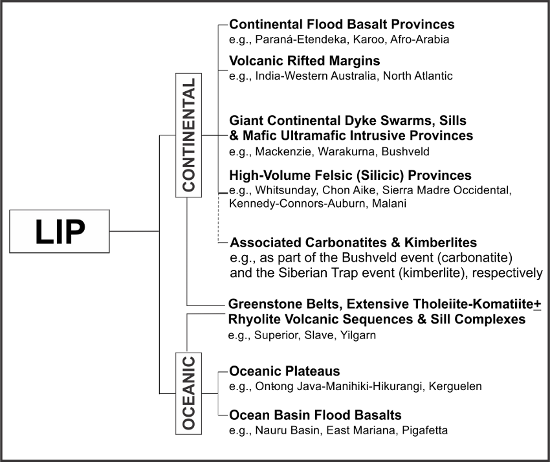
Figure 1: Revised classification of Large Igneous Provinces; modified after Bryan and Ernst (2008) to include associated kimberlites and carbonatites. LIP classifications are based on the initial work of Coffin and Eldholm (1994, 2005).
LIP Record of Canada
In Figures 2 and 3 we schematically summarize the Large Igneous Province (LIP) record of Canada (and adjacent Greenland and the United States), and especially giant dyke swarms; these are the most prominently preserved expression of Proterozoic LIPs, and are particularly useful for recognizing mantle paleo-plumes and associated continental breakup events. The October 2010 LIP of the Month (Claoué-Long and Dean Hoatson, 2010) provided a similar overview of the LIP record for Australia.
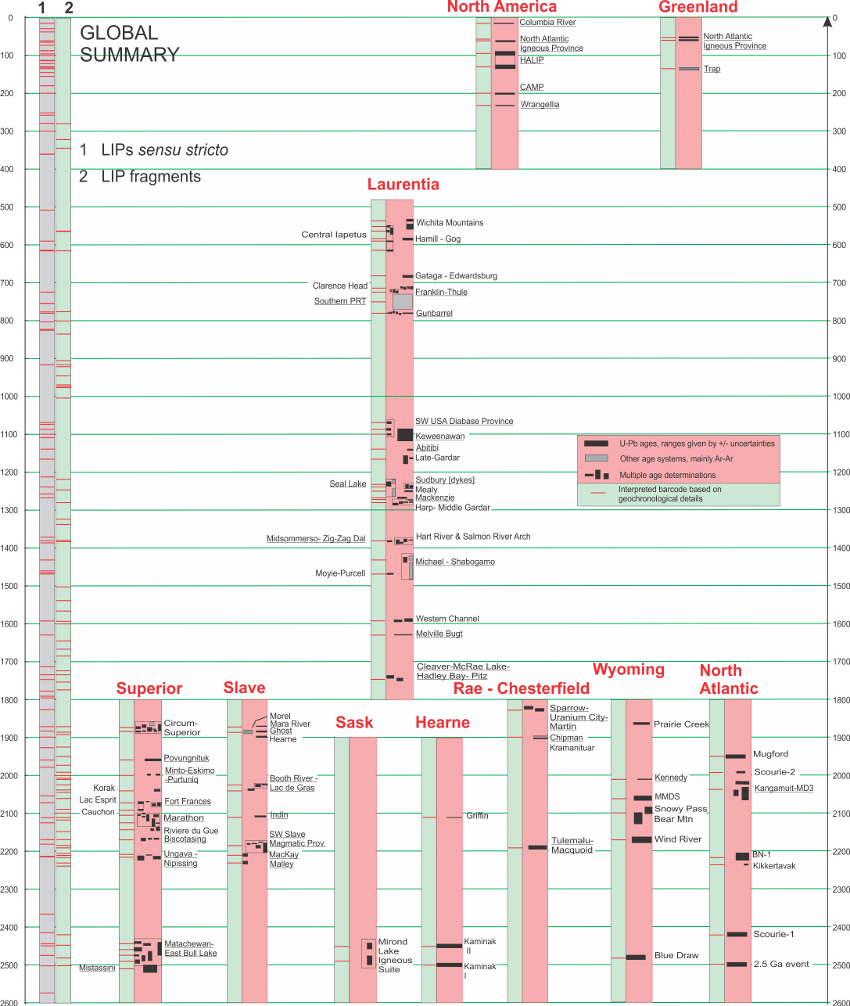
Figure 2: Barcode of Canadian LIP and LIP fragment events discussed herein. Names which are underlined belong to LIPs sensu stricto; those which are not underlined are interpreted to be ”fragments” of LIPs.
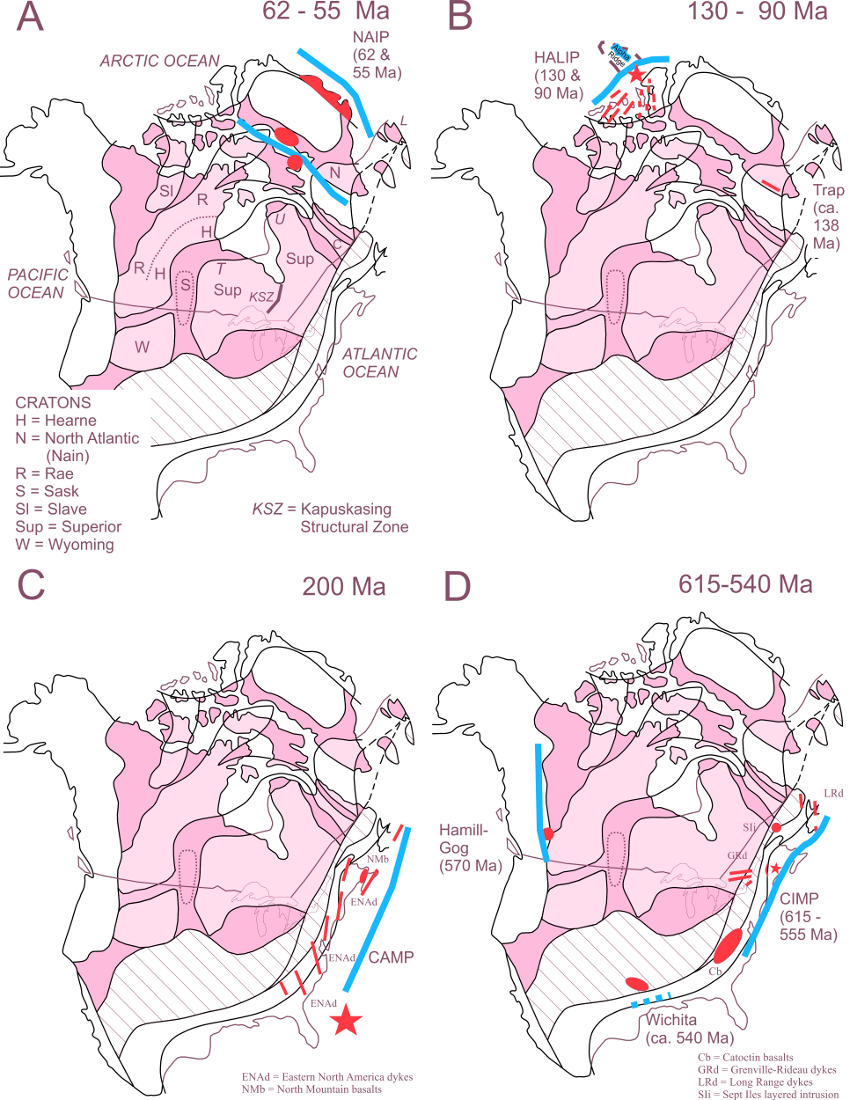
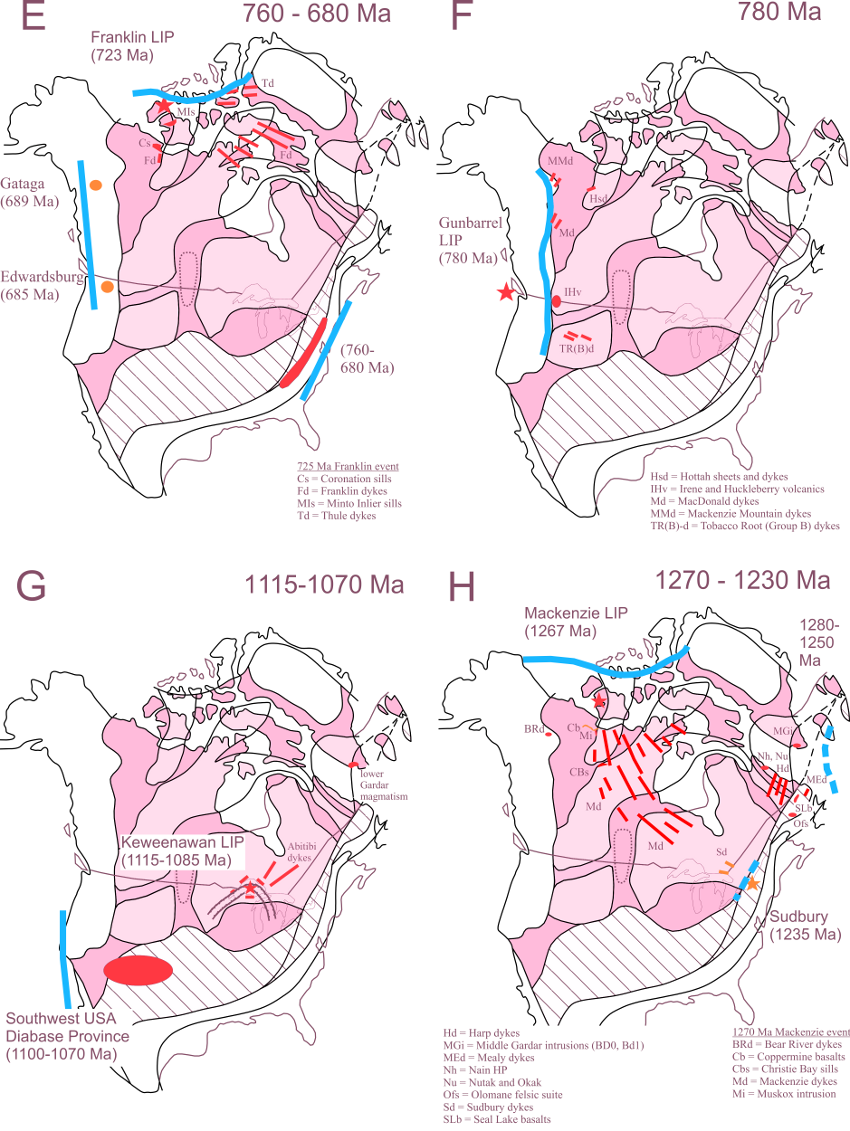
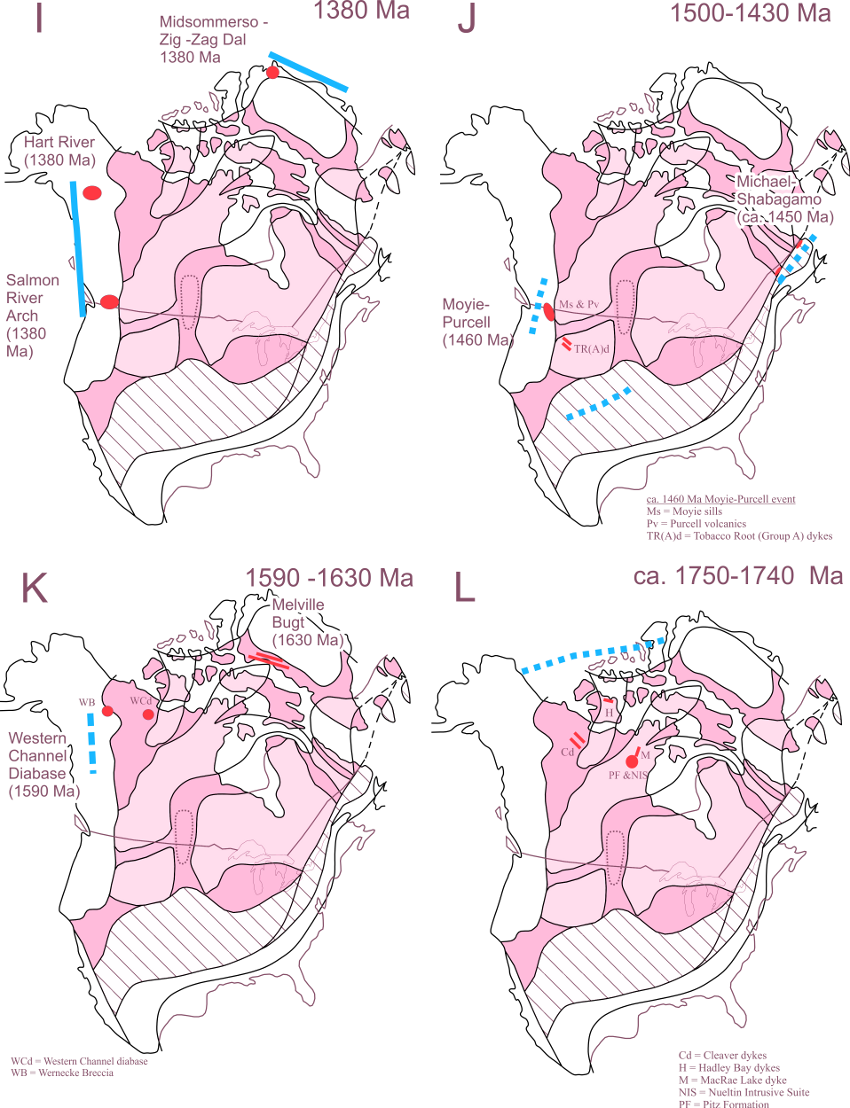
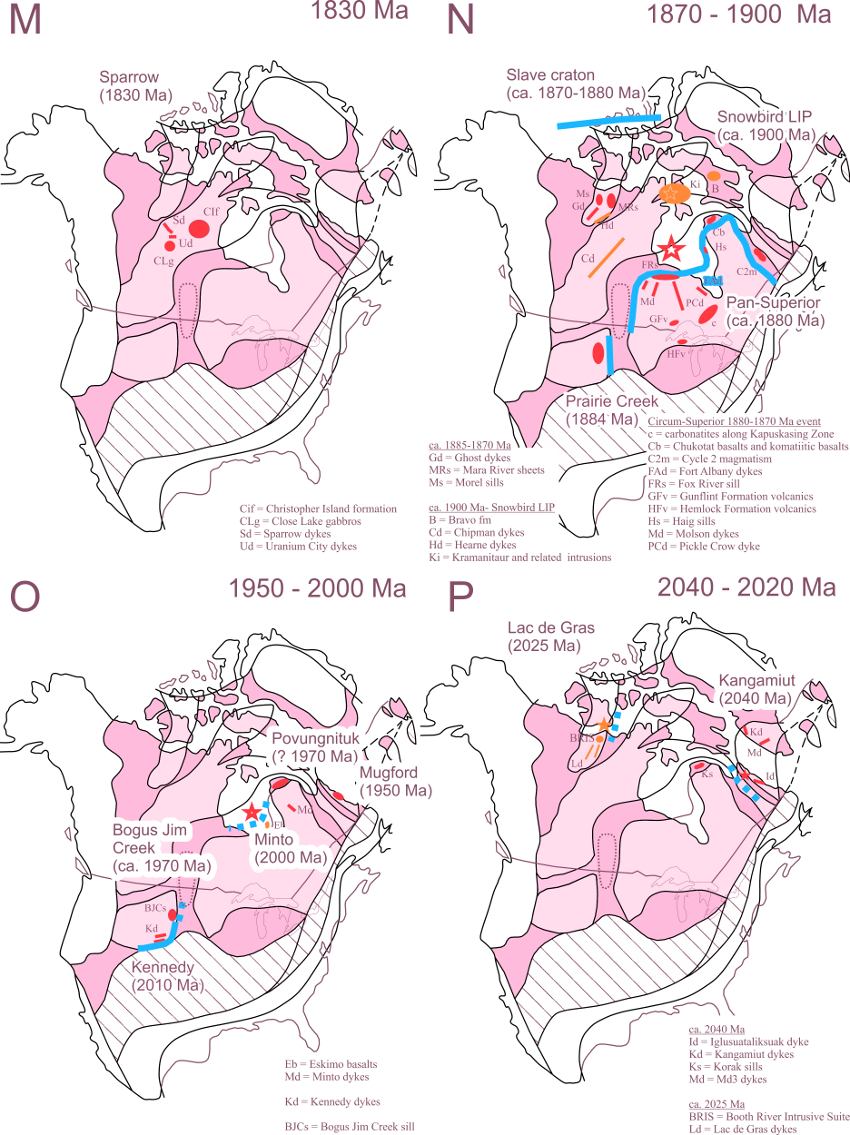
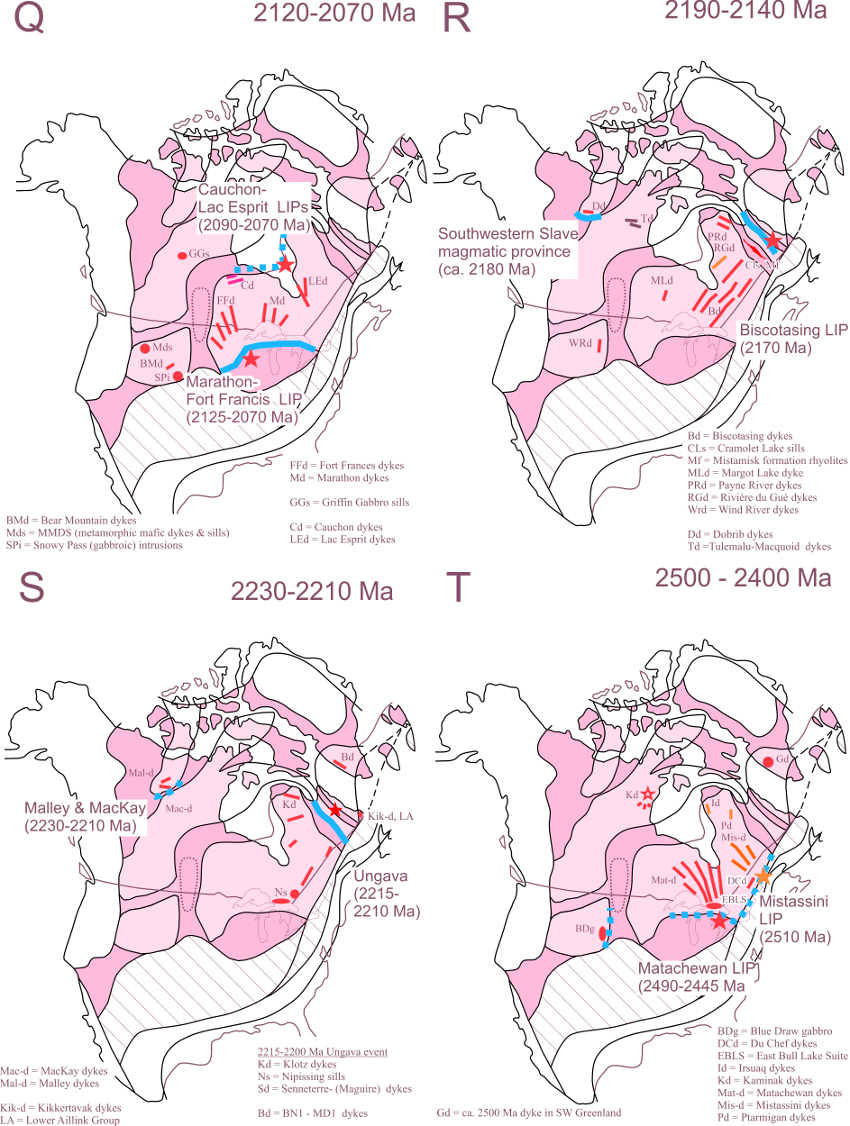
Figure 3: LIPs and their association with specific breakup margins in a Laurentian context. LIP events are shown in red or orange, with broad lines marking dyke swarms, and generalized polygons marking other units (sills, volcanics, layered intrusions). Stars mark plume centres identified as the convergence point of radiating dyke swarms. Blue lines mark the inferred portion of a breakup margin (or attempted breakup margin) that is potentially linked to the given LIP. Background generalized geology modified after Hoffman (1989). Light grey areas marks cratons, dark grey areas mark orogenic belts. Labels for cratons: C = Core Zone, H = Hearne, M = North Atlantic, R = Rae, S = Sask, Sl = Slave, Sup = Superior, and W = Wyoming. Other labels: KSZ = Kapuskasing Structural Zone, T = Thompson promontory and U = Ungava promontory of the Superior craton. L = Lewisian portion of the North Atlantic craton. Modified after Ernst and Bleeker (2010), and LIP distributions are mostly from Ernst and Buchan (2001, 2004), and Buchan and Ernst (2004).
We recognize that we have been liberal (in Figs. 2 and 3) in interpreting intraplate events as LIP fragments, but our enthusiasm is based on the trend over the past 20 years of typical dramatic increases in the known extent of many intraplate events as the vast reservoir of undated dolerites and volcanic units are being dated, and as intraplate events are being traced from one block to another through improving paleocontinental reconstructions (www.supercontinent.org).
We consider the paleocontinental reconstruction history back to 2500 Ma by focussing on breakup margins, and attempt to match each breakup margin of the cratonic blocks that comprise Canada with an associated LIP; this approach is based on the well-established link in the Mesozoic-Cenozoic record between LIPs and continental breakup (e.g., Storey, 1995; Courtillot et al. 1999).
Summary of links with breakup margins
Many LIPs have an associated radiating dyke swarm, which typically converges on a cratonic margin, identifies a mantle plume centre and are linked to breakup or attempted breakup that formed that cratonic margin (Ernst and Bleeker 2010, and references therein).
With reference to Fig. 3, in Paleoproterozoic time the various margins of the Superior craton were linked with LIP events as follows: 2.50-2.45 Ga on the southeast side, 2.22-2.17 Ga on the northeast side, 2.12-2.08 Ga on the south side, and possibly 2.00- 1.97 Ga on the north side (Ungava promontory). An additional event (the Circum-Superior event) at ca. 1.88 Ga is focussed on the Thompson promontory during a time of ocean closure. The Slave craton has numerous Proterozoic LIP events, and those dyke swarm events at ca. 2.1 Ga and 2.2 Ga have weak fanning patterns focussed on the western and eastern sides, respectively. In addition, an event at 2.19 Ga is likely linked to breakup on the southwest to south side of the Slave craton. The North Atlantic craton (southern Greenland and Nain) has ca. 2.04 Ga magmatism linked to its western margin, and 2.24 Ga magmatism may be linked to breakup along the southeastern craton margin. The Wyoming craton has an event at 2.01 Ga linked to breakup along the southeast side. There are several other events at 2.17, 2.11 and 2.49 Ga that are not yet linked to a specific margin of the Wyoming craton. Events within the Hearne craton provide a link with the southern Superior craton in the Paleoproteozoic (Bleeker 2004). Insufficient geochronology is available to constrain the breakup history of the Rae craton.
Mesoproterozoic breakup events at 1.75 Ga, 1.38 Ga are linked with northern and northwestern Laurentia. Neoproterozoic breakout of Laurentia is linked to a ca. 0.72 Ga event on the northern side (possibly separation of Siberia). Ca. 0.7 Ga and ca. 0.62-0.55 Ga events on the eastern margin of Laurentia are linked to the formation of Iapetus ocean and separation of Baltica and possibly Amazonia. Ca. 0.78 and perhaps 0.69 Ga events on the western side of Laurentia are linked with breakup of Australia and/or South China. The youngest LIP events are linked with breakup of Pangea: 0.20 Ga on the east side (formation of the Atlantic Ocean), ca. 0.13 Ga on the north side (formation of the Arctic Ocean).
Discussion
There are a number of implications that follow from this work that can be further investigated:
- In most cases, we have predicted the timing and location of breakup based on the LIP record alone, in the absence of helpful geological evidence of other types, e.g., passive margin sediments. Our interpretation provides a framework for interpreting other geological features of these margins to further test models for the timing and location of breakup.
- We have also used LIPs to identify margins along which breakup was attempted but failed. This important result can identify associated sedimentary sequences that are more properly interpreted as intra-cratonic basins which formed prior to eventual breakup rather than as passive margins, which formed after breakup. Our most prominent example relates to the reconstruction of Karelia against southern Superior and the conclusion that the two blocks remained together until at least 2070-2100 Ma (Bleeker and Ernst 2006). Thus the widespread early Paleoproterozoic (2300-2500 Ma) Huronian Supergroup is not related to breakup of southern Superior craton and therefore does not represent a passive margin sequence but rather an intra-cratonic rift and sagbasin between the Superior and Karelian cratons.
- Some margins have multiple ages for associated LIPs. For instance, the eastern margin of the Superior craton has associated breakup or attempted breakup events at 2215 Ma, 2170-2140 Ma and 1880 Ma. More work is required to sort out which of these events is linked with breakup that formed that margin, and whether to interpret the multiple events in terms of the separation of more than one block.
- A number of the LIPs considered herein are associated with a giant radiating dyke swarm. Such swarms are typically interpreted to result from broad regional uplift associated with a mantle plume. Mantle plume- related uplift is predicted to be on the order of ~1 km, and to be distributed over a broad area of about 2000 km in diameter. Therefore, our interpreted plume centres (marked by stars) shown in Figure 3, which are based on radiating dyke swarms, are predicted to be the centres of broad regional uplift.
- Given that some dyke swarms are greater than 1000 km in length, it is certainly conceivable that a small cratonic block may contain remnants of a swarm that is not linked to breakup along any particular margin of that block, but to another more distant margin on another, originally adjacent block.
- The numerous LIPs and associated mantle plume centres (recognized from radiating dyke swarms) are also potentially hosts for a variety of ore deposits.
References
Bleeker, W. 2003. The late Archean record: a puzzle in ca. 35 pieces. Lithos, v.71, p. 99-134.
Bleeker, W. 2004. Taking the pulse of planet Earth: a proposal for a new multi-disciplinary flagship project in Canadian solid Earth sciences: Geoscience Canada, v. 31, p. 179-190.
Bleeker W, and Ernst R. 2006. Short-lived mantle generated magmatic events and their dyke swarms: The key unlocking Earth's paleogeographic record back to 2.6 Ga. In Dyke Swarms - Time Markers of Crustal Evolution. Edited by E. Hanski, S. Mertanen, T. Rämö, and J. Vuollo. Taylor and Francis/Balkema, London, pp. 3-26.
Bryan, S.E. and Ernst, R.E. 2008. Revised Definition of Large Igneous Provinces (LIPs) . Earth-Science Reviews, v. 86, p. 175-202.
Buchan, K.L., and Ernst, R.E., 2004. Diabase dyke swarms and related units in Canada and adjacent regions. Geological Survey of Canada Map 2022A, with map 1:5,000,000 and accompanying notes.
Claoué-Long, J., and Hoatson, D., 2010. Australian LIPs and the Australian Precambrian ‘barcode’. October 2010 LIP Of The Month. http://www.largeigneousprovinces.org/10oct.html]
Coffin, M.F., and Eldholm, O. 1994. Large igneous provinces: crustal structure, dimensions, and external consequences. Reviews of Geophysics, v. 32, p. 1-36.
Coffin, M.F., and Eldholm, O. 2001. Large igneous provinces: progenitors of some ophiolites? In: Ernst, R.E. and Buchan, K.L. (eds.). Mantle Plumes: Their Classification Through Time Geological Society of America Special Paper 352, p. 59-70.
Coffin, M.F., and Eldholm, O., 2005. Large igneous provinces. In: Encyclopedia of Geology. Edited by R.C. Selley, L.R.M. Cocks, and I.R. Plimer. Elsevier, Oxford, pp. 315-323.
Courtillot, V.E., and Renne, P.R. 2003. On the ages of flood basalt events. C.R. Geoscience, v. 335, p. 113-140, doi: 10.1016/S1631-0713(03)00006-3.
Courtillot, V., Jaupart, C., Manighetti, I., Tapponnier, P., Besse, J., 1999. On causal links between flood basalts and continental breakup. Earth and Planetary Science Letters, v. 166, p. 177-195.
Ernst, R.E. 2007. Mafic-ultramafic large igneous provinces (LIPs): Importance of the pre-Mesozoic record. Episodes, v. 30, p 108-114.
Ernst, R.E., and Buchan, K.L., 2001. Large mafic magmatic events through time and links to mantle-plume heads. In: Mantle Plumes: Their Identification Through Time. Edited by R.E. Ernst, and K.L. Buchan. Geological Society of America Special Paper 352, pp. 483- 575.
Ernst, R.E., and Buchan, K.L. 2004. Large igneous provinces (LIPs) in Canada and adjacent regions: 3 Ga to present. Geoscience Canada, v. 31, p. 103-126.
Ernst, R.E., and Bleeker, W., 2010. Large igneous provinces (LIPs), giant dyke swarms, and mantle plumes: significance for breakup events within Canada and adjacent regions from 2.5 Ga to present Canadian Journal of Earth Sciences, v. 47, p. 695-739, doi: 10.1139/E10-025.
Ernst, R.E., Buchan, K.L., and Campbell, I.H., 2005. Frontiers in Large Igneous Province research. Lithos, v. 79, p. 271-297.
Fahrig, W.F. 1987. The tectonic setting of continental mafic dyke swarms: failed arm and early passive margin. In Mafic Dyke Swarms. Edited by H.C. Halls, and W.F. Fahrig. Geological Association of Canada Special Paper 34, pp. 331-348.
Halls, H.C. 1982. The importance and potential of mafic dyke swarms in studies of geodynamic process. Geoscience Canada, v. 9, p 145-154.
Hoffman, P.F.1989. Precambrian geology and tectonic history of North America In: Bally, A.W., and Palmer, A.R. (eds. ) The Geology of North America – An Overview. Geological Society of America, Decade of North American Geology, A: 447-511.
Storey, B.C., 1995. The role of mantle plumes in continental breakup: Case histories from Gondwanalanad. Nature, v. 377, p. 301-308.
